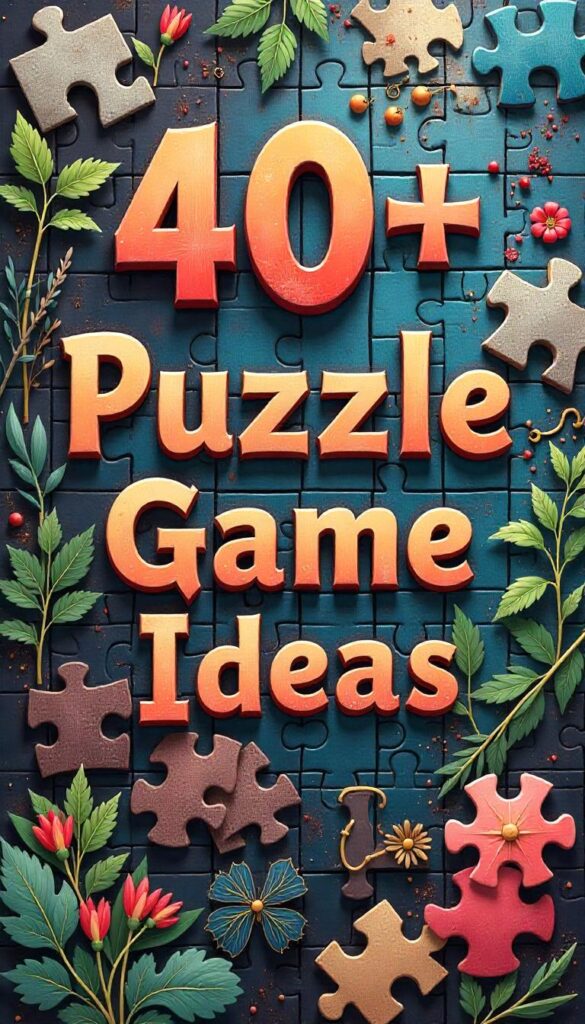Puzzle Game Ideas – Puzzle games are a great way to engage both the mind and body in a fun and challenging way. These games can range from traditional jigsaw puzzles to more complex brain teasers and riddles. Puzzle games encourage critical thinking, problem-solving, and teamwork. For example, jigsaw puzzles involve fitting together pieces based on shapes and pictures, which helps develop spatial awareness and patience.
Crossword puzzles challenge vocabulary and memory, while logic puzzles require reasoning and strategy. Puzzle games can also involve physical puzzles, such as escape room-style games or scavenger hunts, where participants solve clues and complete tasks to unlock the next stage. Whether it’s assembling pieces to form a picture, solving word problems, or cracking codes, puzzle games foster creativity, collaboration, and mental sharpness, making them ideal for family fun, team-building activities, or individual challenges. They can be adapted for all ages and skill levels, providing endless possibilities for entertainment and learning.
Top Party Planners Near You in Your Area
Puzzle Game Ideas
Here’s a list of over 100 Puzzle Game Ideas that cater to various age groups and interests, including kids, seniors, adults, and family-friendly activities. These puzzle games can be adapted to different skill levels and provide fun, brain-stimulating challenges.
Puzzle Game Ideas for Kids (Ages 3-12)
- Jigsaw Puzzles (Various pieces and difficulty levels)
- Shape Sorters (Shape matching and sorting)
- Memory Matching Game (Flip cards to match pairs)
- Animal Puzzle (Match animals with their habitats)
- Alphabet Puzzle (Matching letters to pictures)
- Number Puzzle (Connect numbers in order)
- Color Matching Game (Match colored tiles to a palette)
- Build-A-Word Puzzle (Form simple words from letters)
- Maze Puzzles (Guide a character through a maze)
- Tangram Puzzles (Rearrange pieces to form shapes)
- Hidden Object Puzzle (Find items in busy scenes)
- Animal Sound Matching Game (Match animals with their sounds)
- Letter or Number Jigsaw (Form letters/numbers from pieces)
- Rhyming Puzzle (Match rhyming words or sounds)
- Puzzle Blocks (Arrange colorful blocks to form pictures)
- Shape Identification Puzzle (Match shapes to their names)
- Pattern Matching Game (Find the next item in a sequence)
- Puppet Puzzle (Build a character using puzzle pieces)
- Puzzle Books (Sudoku or crossword puzzles for kids)
- Animal Matching Game (Match animal names with pictures)
- Color-by-Number Puzzle (Color pictures using numbers)
- Simple Crossword Puzzles (Beginner-level puzzles)
- Building Blocks Puzzle (Construct a model from pieces)
- Sound Puzzle (Match sounds to images)
- Story Puzzle (Put jumbled pictures into the correct order)
- Sliding Puzzle (Move tiles around to solve an image)
- Connect the Dots Puzzle (Form images by connecting numbered dots)
- Puzzle Cards (Match puzzle pieces with a picture on the card)
- Treasure Hunt Puzzle (Solve clues to find a hidden object)
- Tic-Tac-Toe Puzzle (Classic grid-based puzzle)
Puzzle Game Ideas for Adults (Ages 18+)
- Crossword Puzzles (Classic word-solving puzzles)
- Sudoku (Number puzzles for logic and strategy)
- Jigsaw Puzzles (Advanced 1000-piece or higher puzzles)
- Kakuro (Number-based puzzles that resemble Sudoku)
- Cryptograms (Decrypt messages from encoded letters)
- Word Search (Find words hidden in a grid of letters)
- Logic Puzzles (Solve problems using deductive reasoning)
- Nonograms (Picross) (Color-in grid puzzles that form a picture)
- Sliding Puzzle (Move pieces around to form a picture)
- Tangrams (Fit shapes together to form a figure)
- Riddles (Solve creative and challenging riddles)
- Brain Teasers (Puzzles designed to challenge the brain)
- KenKen (Math-based puzzle like Sudoku but with arithmetic)
- Minesweeper (Solve puzzles by revealing safe squares)
- Jigsaw Puzzle Races (Compete against friends to complete the puzzle first)
- Trivia Puzzles (Answer trivia questions to solve a puzzle)
- Picture Puzzle (Rearrange pieces to recreate an image)
- Anagram Puzzle (Rearrange letters to form words)
- Logic Grid Puzzles (Solve puzzles using clues and elimination)
- Escape Room Puzzle (Solve a series of puzzles to escape from a locked room)
- Board Game Puzzles (Use strategy and logic to complete puzzles)
- Cryptic Crosswords (Challenging crossword with wordplay)
- Strategy Puzzle Games (Chess puzzles, checkers)
- Jumble Puzzle (Unscramble letters to form words)
- Puzzle Apps (Mobile apps like Sudoku, Wordscapes, and more)
- Rebus Puzzles (Interpret pictures or symbols representing phrases)
- Cipher Puzzles (Crack codes and ciphers to unlock puzzles)
- Word Ladder Puzzles (Change one word into another by altering one letter at a time)
- Pattern Recognition (Identify patterns and sequences in puzzles)
- Rube Goldberg Puzzle (Create a complex machine to achieve a simple task)
Puzzle Game Ideas for Seniors (Ages 60+)
- Jigsaw Puzzles (Choose puzzles with large pieces for ease)
- Crossword Puzzles (Daily or themed crossword puzzles)
- Sudoku (Large print Sudoku for easier reading)
- Word Search (Larger grids with simple words)
- Memory Games (Simple memory matching cards)
- Dominoes (Match tiles in this classic game)
- Picture Puzzles (Large-format photo puzzles)
- KenKen (Easy number puzzles)
- Dot-to-Dot Puzzles (Connect dots to form an image)
- Match Pairs Puzzle (Find matching pairs of cards)
- Scrabble (Create words from tiles to score points)
- Sudoku Variants (Samurai Sudoku, Killer Sudoku)
- Puzzle Books (Activity books with logic, number, and word puzzles)
- Noodle Puzzles (Form shapes using flexible noodle pieces)
- Sequence Puzzles (Identify the next number in a sequence)
- Word Scramble (Unscramble letters to form words)
- Mosaic Puzzles (Assemble colorful pieces to form a picture)
- Matchstick Puzzles (Move matchsticks to form shapes)
- Number Grid Puzzles (Fill in missing numbers in a grid)
- Pattern Blocks (Create pictures using geometric shapes)
- Tile Puzzles (Slide pieces to form a complete image)
- Trivia Puzzles (Answer trivia questions to complete the puzzle)
- Tangram Puzzle (Fit shapes into a defined space)
- Cryptic Puzzles (Solve puzzles with coded clues)
- Lateral Thinking Puzzles (Solve through creative reasoning)
- Logic Grid Puzzles (Use clues to eliminate and deduce answers)
- Word Association Puzzle (Find related words)
- Maze Puzzle (Navigate through a maze to reach the goal)
Puzzle Game Ideas for Families
- Family Jigsaw Puzzle (Get the whole family involved in completing a puzzle)
- Board Games (Monopoly, Scrabble, and Clue are great for family puzzle challenges)
- Pictionary (Draw clues to help family members guess the word)
- Charades (Act out clues to help others guess the word)
- Puzzling Trivia (Answer questions from various categories to win)
- Puzzle Races (Race to complete different puzzles first)
- Find the Hidden Object (Hide small items around the room and have the family find them)
- Shape and Color Sorting Puzzles (Sort shapes and colors to create a pattern)
- Escape Room at Home (Solve puzzles to escape a themed room)
- Puzzle Scavenger Hunt (Solve clues to find the next puzzle piece)
- Magic Square Puzzle (Arrange numbers so the rows and columns all add to the same number)
- Tactile Puzzles (Use textures and tactile pieces to complete puzzles)
Top Party Planners Near You in Your Area
Online Puzzle Game Ideas
- Online Crossword Puzzles (Websites that offer daily puzzles)
- Wordle (Guess the word by filling in letters)
- Online Sudoku (Play Sudoku puzzles on various websites and apps)
- Jigsaw Puzzle Apps (Digital versions of jigsaw puzzles)
- Online Escape Rooms (Participate in online escape room challenges)
- Trivia Quiz Games (Online trivia puzzle games with different categories)
- Cryptic Crosswords Online (Web-based cryptic crossword puzzles)
- Online Mystery Puzzles (Solve a mystery by solving puzzles along the way)
- Puzzle Apps (Downloadable apps that offer a variety of puzzles)
- Mobile Puzzle Games (Games like 2048, Threes, and more on mobile devices)
Creative and Unconventional Puzzle Game Ideas
- Interactive Story Puzzles (Solve puzzles to progress through a story)
- Puzzle Box (Solve physical puzzles in a box to open it)
- Jigsaw Puzzle Cubes (Build a 3D puzzle)
- Logic Riddles (Solve logic-based riddles)
- Puzzle Hunt (Solve multiple puzzles to lead to a final treasure)
- Puzzle-Themed Dinner (Solve puzzles at the dinner table for rewards)
- DIY Puzzle Crafting (Create personalized puzzles as a family activity)
- Digital Picture Puzzles (Upload personal photos and turn them into puzzles)
- Math Puzzle Challenges (Solve complex math-based puzzles)
- Escape Room Kit (Purchase or create a DIY escape room puzzle set)
- Puzzle Relay Race (Compete to solve different puzzles in a team relay format)
- Puzzling Cooking Challenge (Complete cooking tasks that involve puzzle-solving)
Strategy Puzzle Game Ideas
- Chess Puzzles (Solve chess-based puzzle scenarios)
- Checkers Strategy Puzzle (Strategize moves to solve checkers puzzles)
- Backgammon (Classic game with strategy-based challenges)
- Connect Four Puzzle (Create four in a row with strategic moves)
- Rubik’s Cube (Solve the cube using logic and algorithms)
- Boggle (Create as many words as possible with letter dice)
- Tic-Tac-Toe Variations (Play with different rules and challenges)
- Mastermind (Guess the hidden color pattern through logic and deduction)
These puzzle ideas span a variety of difficulty levels, ages, and types, ensuring that everyone from kids to adults and seniors can enjoy a fun and brain-engaging activity.
Below is a detailed list of requirements and how to play for some of the puzzle games mentioned, categorized for kids, adults, and seniors:
Top Party Planners Near You in Your Area
1. Jigsaw Puzzles
Requirements:
- A set of jigsaw puzzle pieces (typically ranging from 50 to 1000+ pieces)
- A large, flat surface for assembling the puzzle (e.g., a table or a floor)
- Good lighting
How to Play:
- Prepare: Clear a flat space and sort the puzzle pieces by edge pieces and colors.
- Edge Pieces: Start by assembling the border (edge pieces), forming the frame of the puzzle.
- Building: Begin filling in the inner sections by matching colors, patterns, or shapes. Work on small sections and connect them as you go.
- Complete: Once all pieces are connected, ensure the puzzle is perfectly fitting. This may take several sessions based on puzzle difficulty.
- Display: After completing, you can frame the puzzle or disassemble it to play again.
2. Crossword Puzzles
Requirements:
- A crossword puzzle book or printable puzzles (or an app for digital versions)
- Pen or pencil (for paper puzzles) or a touchscreen for digital puzzles
- Knowledge of words and clues
How to Play:
- Read the Clues: Begin by reading the clues for across and down words. Start with the easiest ones.
- Fill in Answers: Write the answers in the corresponding boxes. Use the intersecting clues to help solve more difficult words.
- Use Word Structure: Some words will have a specific number of letters, and others will cross at specific spots—use this to fill in the blanks.
- Complete the Puzzle: Keep solving until all clues are answered, using logic and word knowledge to figure out the difficult words.
3. Sudoku
Requirements:
- A Sudoku puzzle grid (usually a 9×9 grid with smaller 3×3 sections)
- Pencil or pen (erasable for beginners)
- Basic math skills (numbers 1-9)
How to Play:
- Understand the Grid: The grid consists of 9 rows and 9 columns, with some numbers already filled in.
- Rules: Each row, column, and 3×3 box must contain each number from 1 to 9 exactly once.
- Solve Step by Step: Begin by filling in numbers where they’re easily deduced. Use logic to narrow down possible numbers for each empty spot.
- Check for Accuracy: After filling out the grid, check that all the numbers satisfy the rules (no duplicates in any row, column, or box).
- Complete: Continue this process until the grid is fully filled in and correct.
4. Word Search
Requirements:
- A word search puzzle sheet (can be printed or digital)
- A pen or highlighter (to mark found words)
- A list of words to find
How to Play:
- Get the Word List: Start with a word list provided with the puzzle. The list contains the words hidden in the grid.
- Search the Grid: Look for the words in the grid. Words can be horizontal, vertical, diagonal, or backwards.
- Mark Words: As you find each word, circle or highlight it.
- Complete the Puzzle: Once all words from the list are found, the puzzle is complete.
5. Tangrams
Requirements:
- A tangram puzzle set (7 pieces: 5 triangles, 1 square, 1 parallelogram)
- A flat surface for assembling shapes
How to Play:
- Separate the Pieces: Start by separating all 7 pieces.
- Understand the Goal: The goal is to arrange the pieces to form a specific shape (e.g., a bird, house, etc.).
- Follow Instructions: If a template or challenge is provided, use it to guide the assembly of the shapes.
- Rearrange Pieces: Try different combinations of the 7 pieces to create the required shape. There are often many solutions for a single puzzle.
- Challenge Yourself: Try creating your own shapes once you’ve mastered the basic puzzles.
6. Sliding Puzzle
Requirements:
- A sliding puzzle set (usually a 3×3 or 4×4 grid with one empty space)
- A flat surface to work on
How to Play:
- Understand the Goal: The goal is to move the tiles into the correct order, starting with a scrambled set of numbered or picture pieces.
- Plan Your Moves: Each piece can only slide into the empty space, so you need to plan your moves carefully to organize the pieces.
- Rearrange: Use the empty space to move tiles, working your way towards the completed arrangement.
- Complete the Puzzle: When all pieces are in the correct order, the puzzle is complete.
7. Cryptograms
Requirements:
- A cryptogram puzzle (usually a short phrase or quotation)
- Pen or pencil (to write down guesses)
- Knowledge of word patterns
How to Play:
- Understand the Cipher: In cryptograms, each letter is substituted with another letter. Your job is to decode the message.
- Analyze Patterns: Start by looking for single-letter words or common letter combinations like “the” or “and.”
- Make Guesses: Use letter frequency and logic to guess letters and decode the message.
- Complete the Puzzle: Continue decoding until the full message is revealed.
8. Picture Puzzle
Requirements:
- A set of picture puzzle pieces (could be cut into shapes or fragments of a photo)
- A large flat surface to arrange the pieces
How to Play:
- Sort Pieces: Begin by sorting the pieces according to color, edges, and patterns.
- Create the Border: Start with edge pieces to form the border of the picture.
- Fill in the Center: Work on the inner sections, matching colors and images that fit together.
- Complete the Picture: Continue assembling until all pieces are in place and the image is completed.
9. Logic Grid Puzzle
Requirements:
- A logic grid puzzle sheet (usually with categories and clues)
- Pen or pencil (to mark answers)
- Logical thinking and deduction skills
How to Play:
- Read the Clues: Start by reading all the clues. These clues will provide information about categories and relationships.
- Fill in the Grid: Use the clues to mark connections (e.g., “John likes apples” could be noted in a specific grid square).
- Eliminate Possibilities: Use the process of elimination to narrow down options.
- Complete the Grid: Continue solving using logic to fill in all the categories correctly.
10. Sudoku Variants
Requirements:
- A variant Sudoku grid (e.g., Samurai Sudoku, Killer Sudoku)
- A pencil or pen
- Logical thinking and math skills
How to Play:
- Understand the Rules: The rules are similar to traditional Sudoku, but each variant has its unique set of challenges.
- Analyze the Grid: Look for numbers already filled in and use those as starting points.
- Solve Step by Step: Use logic to deduce the correct number for each empty space.
- Complete the Puzzle: Continue until the grid is fully filled, following the rules of the variant.
These are just a few examples of how to play popular puzzle games, and each can be adapted to fit different age groups or difficulty levels. The key to solving puzzles is patience, practice, and sometimes a bit of creative thinking!
11. Memory Match Game
Requirements:
- A set of memory cards (with pairs of matching images or words)
- A flat surface (like a table or the floor)
How to Play:
- Shuffle the Cards: Lay out the cards face down on the table in a grid formation.
- Take Turns: Players take turns flipping over two cards at a time, trying to find matching pairs.
- Remember: After each turn, players must try to remember the locations of the cards they’ve seen.
- Match Pairs: If a player finds a match, they keep the pair and take another turn.
- End of the Game: The game ends when all the pairs have been matched. The player with the most pairs wins.
12. Maze Puzzle
Requirements:
- A maze puzzle sheet or printable maze (or a digital maze app)
- Pen or pencil (or finger for digital versions)
How to Play:
- Start at the Entrance: Find the starting point of the maze and the goal or exit point.
- Navigate the Maze: Trace your path through the maze, avoiding dead-ends and obstacles.
- Use Trial and Error: If you hit a dead-end, backtrack and try a different path.
- Reach the Exit: Continue navigating the maze until you reach the exit.
- Challenge Yourself: Try to solve the maze in the least amount of time, or increase the difficulty level for more challenges.
13. Hidden Object Puzzle
Requirements:
- A printed or digital hidden object puzzle sheet (an image with objects scattered within)
- A pen or pencil (to check off found objects)
How to Play:
- Review the Object List: Look at the list of objects that are hidden within the image.
- Search the Image: Scan the image for the objects listed, checking them off as you find them.
- Complete the Search: Continue until all objects on the list are found within the picture.
- Recheck the Image: Double-check that all objects have been located and correctly identified.
- Challenge: Try timed versions for added difficulty or use a larger and more detailed image.
14. Spot the Difference
Requirements:
- A pair of images (either printed or digital) with subtle differences between them
- Pen or pencil (to mark found differences)
How to Play:
- Compare the Images: Examine the two images side by side and look for differences.
- Find the Differences: Identify the changes, such as missing objects, color variations, or changes in position.
- Mark the Differences: Mark each difference as you find them.
- Complete the Puzzle: Continue until you have found all the differences.
- Increase the Challenge: Try puzzles with more differences or time yourself to beat your record.
15. Sudoku Variants (Samurai Sudoku, Killer Sudoku, etc.)
Requirements:
- A Sudoku variant grid (Samurai Sudoku, Killer Sudoku, etc.)
- Pen or pencil
- Logical reasoning skills
How to Play:
- Understand the Variant’s Rules: Each Sudoku variant will have unique rules in addition to the basic Sudoku rules. For example, in Killer Sudoku, groups of cells are added together to form specific totals.
- Analyze the Grid: Review the numbers already filled in and work with the restrictions of the variant (e.g., box totals in Killer Sudoku).
- Logical Deduction: Use process of elimination to fill in the numbers that fit within the given constraints.
- Complete the Grid: Continue solving until the entire grid follows the variant’s rules.
- Challenge Yourself: Try solving different variants of Sudoku, starting from beginner to expert levels.
16. Word Scramble
Requirements:
- A list of scrambled words (can be printed or digital)
- Pen or pencil (to write answers)
How to Play:
- Review the Scrambled Words: Look at the list of scrambled words that need to be unscrambled.
- Unscramble the Words: Try to rearrange the letters to form a correct word.
- Write Down Answers: Write down the unscrambled words.
- Check for Accuracy: After solving, check if the words are correct by cross-referencing with a dictionary or word list.
- Set a Timer: For added challenge, time yourself or compete with others to see who can unscramble the most words in a set time.
17. Brain Teasers (Riddles)
Requirements:
- A list of brain teasers or riddles (printed or digital)
- Pen or paper (optional, to write down answers)
- Good thinking and reasoning skills
How to Play:
- Read the Riddle: Begin with one riddle at a time. Read it carefully.
- Think Outside the Box: Brain teasers often require creative or lateral thinking, so think beyond the obvious.
- Write Down Your Guess: If unsure, jot down potential answers, or ask for clues.
- Verify the Answer: Check if your answer is correct after giving it a try.
- Complete the List: Move on to the next riddle once the current one is solved, continuing until all the riddles are completed.
18. Rubik’s Cube
Requirements:
- A Rubik’s Cube (3×3 or 4×4 cube)
- A guide or instructions (optional, for beginners)
- Time and patience
How to Play:
- Start with Solving the First Layer: Begin by solving one face of the cube. This involves getting all the pieces of the same color on one face.
- Solve the Middle Layer: Work on the middle layer by moving pieces into their correct positions without disturbing the solved first layer.
- Finish with the Final Layer: Use algorithms to orient the pieces in the final layer and complete the cube.
- Practice and Learn Algorithms: Over time, learn specific moves (algorithms) that help you solve the cube faster.
- Complete the Cube: Once all sides of the cube are completed with uniform colors, the puzzle is solved.
19. Brain Games (Lateral Thinking Puzzles)
Requirements:
- A set of lateral thinking puzzles (either printed or digital)
- Pen or paper (optional for note-taking)
- Critical thinking and deductive reasoning
How to Play:
- Read the Puzzle: Start with one lateral thinking puzzle, which often involves solving a seemingly impossible situation.
- Ask Questions: The puzzle master answers only “yes” or “no” to any questions you ask.
- Analyze Clues: Use the answers to your questions to analyze the scenario and start deducing logical answers.
- Solve the Puzzle: Continue asking questions until you figure out the solution.
- Move to Another Puzzle: Once solved, move on to another puzzle and keep practicing to improve your thinking process.
20. Logic Puzzles (Pathfinding, Sequence Solving, etc.)
Requirements:
- A logic puzzle book or printable puzzles
- Pen or pencil (for making notes or marking answers)
- Problem-solving skills
How to Play:
- Read the Puzzle: Begin by reading the instructions for the specific type of logic puzzle (e.g., finding a path or solving sequences).
- Analyze Clues: Break down the clues and visualize the scenario.
- Use Deductive Reasoning: Apply logic to solve the puzzle, eliminating possibilities and narrowing down the correct answer.
- Solve the Puzzle: Once you’ve used all clues effectively, solve the puzzle and double-check your answer.
- Challenge Yourself: Try more difficult puzzles with multiple solutions or more complex scenarios.
These Puzzle Game Ideas provide a range of challenges for different age groups and skill levels. The key is to develop patience, problem-solving abilities, and a methodical approach to solving each type of puzzle. Enjoy the mental workout!
Top Party Planners Near You in Your Area

Hi, I’m Maggie Culp, the founder of PartyVibesFun.com, based in North Little Rock, Arkansas, United States! With a passion for creating unforgettable celebrations, I specialize in turning any event into a fun and vibrant experience. From birthday parties to themed gatherings, I’m here to help you bring your party ideas to life with ease and excitement. Whether you’re looking for unique games, creative themes, or party planning tips, I’m dedicated to making sure every moment of your event is filled with joy. Let’s create memories together and make your next party the talk of the town!





